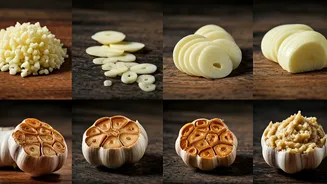Mincing for Flavor
Mincing garlic is essential when you want a strong, immediate flavor burst in your dish. Start by peeling the garlic cloves. Use a chef's knife and mince
by rocking the knife back and forth over the garlic. This process breaks down the cell walls, releasing the allicin, the compound responsible for garlic's pungent taste. The finer you mince, the more potent the flavor will be. Mincing is perfect for sauces, marinades, and dishes where you want garlic to be evenly distributed and fully integrated. Be mindful that minced garlic can burn quickly, so add it near the end of the cooking process or in low-heat situations. With proper mincing, your food gets an immediate and impactful garlic flavor, making it a cornerstone for many recipes. Ensure your knife is sharp for ease and safety.
Slicing for Texture
Slicing garlic creates thin, uniform pieces that offer a more subtle flavor and interesting texture. Begin by trimming the root end and peeling the garlic cloves. Lay the cloves flat and slice them lengthwise into thin, consistent slices. Slicing is excellent for dishes where you want to taste garlic without overpowering the other ingredients. Sliced garlic provides visual appeal and a pleasant texture, making it ideal for stir-fries, pasta dishes, and toppings. It releases its flavor more slowly than minced garlic, allowing it to cook longer without burning. This method is preferred when you aim for a balance of flavors and a slight bite. Always be careful when slicing, making sure your knife is sharp for a clean cut.
Dicing for Uniformity
Dicing garlic involves cutting it into small, even cubes. Peel your garlic cloves and slice them lengthwise, then cut them crosswise to create small squares. Dicing offers a balanced approach, providing a good balance of flavor and texture, suitable for many recipes. The size of the dice dictates the intensity of the flavor and the cooking time needed. Larger dices require longer cooking to soften and release their flavors, while smaller dices cook quickly and release more flavor rapidly. Diced garlic is perfect for soups, stews, and sautéed dishes where you want garlic to be a consistent part of the dish without being too overpowering. Consistency in size ensures even cooking and flavor distribution. This technique is often used when visual appeal and flavor balance are essential.
Smashing for Aromatics
Smashing garlic is a quick and efficient method for releasing its aroma and flavor. Place the unpeeled garlic clove on a cutting board, then use the flat side of a chef's knife to press down firmly until the clove crushes. This method is quick and ideal for releasing a lot of flavour. Smashing is especially useful for infusing oils or adding garlic to braising liquids. You can then easily remove the crushed cloves after they've imparted their flavor. This method is less about the garlic's texture and more about its aroma, offering a robust flavor profile. It's often employed when you want a subtle garlic presence in your dish without the actual pieces of garlic. The flavor is infused quickly, making it a great choice for quick cooking tasks.
Microplaning for Intensity
Microplaning garlic, using a microplane or fine grater, creates a garlic pulp with maximum flavor and intensity. Peel the garlic cloves and grate them directly onto your dish. The fine grating creates a puree-like consistency. Microplaned garlic is incredibly potent, so use it sparingly. It's excellent for adding a burst of fresh garlic flavor to sauces, dressings, and dips. Because it's so fine, microplaned garlic will quickly infuse a dish with its strong flavor. This method works well for raw garlic applications where you want to avoid chunks. The microplane method extracts all the flavor in a single pass, resulting in an immediate and intense garlic experience. Be cautious as microplaned garlic has a very strong taste profile.
Chopping for Chunky Bites
Chopping garlic produces uneven pieces, providing varying textures and flavor pockets in your cooking. Peel the garlic cloves and chop them roughly with a chef's knife, aiming for pieces of different sizes. Chopping can be perfect for dishes where you want a rustic, handmade feel. This method allows for a more varied flavor profile because some pieces may cook faster than others, creating different levels of garlic flavor throughout the dish. This technique is often used in situations where you want both the flavor and a bit of the texture of garlic to be prominent, as it offers a less uniform and more pronounced presence. Ideal for making hearty dishes and giving visual interest.
Whole Cloves for Roasting
Roasting garlic whole transforms the cloves into a sweet, mellow, and spreadable ingredient. Leave the garlic cloves unpeeled and slice off the top. Drizzle with olive oil and wrap in foil before roasting in the oven. Roasting mellows the garlic's sharpness, creating a soft, caramelized texture. Whole roasted cloves are delicious on their own, spread on bread, or added to sauces and purees. This method is not about chopping the garlic, but about cooking it in a way that alters its flavor profile entirely. Roasting concentrates the garlic's flavors, making it less pungent and more savory. The result is a smooth, caramelized flavor that's both sweet and complex, suitable for a variety of culinary applications.









